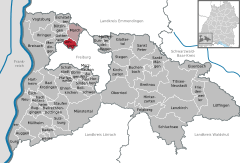Umkirch
| Umkirch | ||
|---|---|---|
| ||
 Umkirch | ||
Location of Umkirch within Breisgau-Hochschwarzwald district 
 | ||
| Coordinates: 48°01′58″N 07°45′49″E / 48.03278°N 7.76361°ECoordinates: 48°01′58″N 07°45′49″E / 48.03278°N 7.76361°E | ||
| Country | Germany | |
| State | Baden-Württemberg | |
| Admin. region | Freiburg | |
| District | Breisgau-Hochschwarzwald | |
| Government | ||
| • Mayor | Walter Laub | |
| Area | ||
| • Total | 8.72 km2 (3.37 sq mi) | |
| Population (2015-12-31)[1] | ||
| • Total | 5,400 | |
| • Density | 620/km2 (1,600/sq mi) | |
| Time zone | CET/CEST (UTC+1/+2) | |
| Postal codes | 79224 | |
| Dialling codes | 07665 | |
| Vehicle registration | FR | |
| Website | www.umkirch.de | |
Umkirch is a municipality in the district Breisgau-Hochschwarzwald in Baden-Württemberg, Germany. It is located around 5 kilometres west of Freiburg im Breisgau.
History
The settlement has existed since Roman times (about 100 BC) and was called Ecclesia in Undis (Church beneath the Waves - maybe because of the two small rivers floating passing through the village). Sigillat shrds and coins were found and the church was built onto a Roman building, as a part of its wall was found.
When the Romans left in sixth century, Allemanian clans settled in Umkirch, ruled by the Lords of Üsenberg, a noble family. After they were vanquished, the family of Kageneck ruled the area. In 1806, Umkirch became part of the district of Freiburg.
Historically, it is first mentioned in 1087 in a document about the exchange of the monastery St. Ulrich in the Hexental (Witches' Valley) between the Bishop of Basel, Burkard, and the Monastery of Cluny in France. A witness present at the deal is named as "Humbert de Untkilcha". In 1270, Umkirch is given to the knight Dietrich Snewlin, later to several others, among them Martin Malterer, the count palatines of Tübingen and Flora Countess of Wrbna, until it was given to Grand Duchess Stephanie of Baden.
Part of Umkirch is the village of Dachswangen: in 1924 it became part of the village.
On April 20, 1945, Umkirch was occupied by the French after World War II. It was administered by governor Pierre Pène. During World War I, Umkirch lost twenty-one citizens, during World War II, thirty citizens. Twelve others are recorded as missing in action.
Church
The first church in Umkirch was built by a Frankish magistrate, called Centenarius Elilant. He was also called "Hunde" (meaning leader of a hundred). Apparently this name was given to the village: Hundechilche, meaning "Hunde's Church". The church of Umkirch dates back to the second half of the eleventh century. It is one of the oldest churches in Breisgau. The church was mentioned first in a letter, dated April 14, 1139 from Pope Innocent II, to Basel.
Economy and infrastructure
Umkirch is a separate community; it has still maintained its village-like character. However, this idyll is influenced by the freeway which leads through 20.000 cars a day through the city, which create often traffic jams. One of the reasons is possibly the location of the industrial area just opposite the freeway connection. Also, the creation of high-riser restroyed much of the village atmosphere.
With the freeway, there exists a very good connection to the highway A5 and to Freiburg, whose city can be reached within fifteen minutes. A beltway has been built, leading the major part of the traffic around the village.
 Aerial view of Umkirch
Aerial view of Umkirch_4929.jpg) The church of Umkirch
The church of Umkirch The palace of the House of Hohenzollern-Sigmaringen (private property)
The palace of the House of Hohenzollern-Sigmaringen (private property)
Politics
Mayors
Year denotes date when they first occupied office:
- 2002 Walter Laub
- 1986 Ulrich Greschkovitz
- 1959 Franz Heitzler
- 1946 Serafin Frieder
- 1946 Franz Spiegelhalter
- 1945 Anton Hirzle
- 1941 Serafin Risch
- 1935 Theodor Knoll
- 1920 Wilhelm Hirzle
- 1900 Johann Kirner
- 1870 Franz Xaver Spiegelhalter
- 1862 Josef Hercher
- 1859 Mathias Hirzle
- 1832 Johann Schweitzer/Schweizer
District Council
The local elections on June 13, 2004 resulted in the following seating:
| CDU | 45,1% | -7,3 | 6 seats | -2 |
| UBU | 33,2% | +33,2 | 5 seats | +5 |
| SPD | 21,7% | -7,7 | 3 seats | -1 |
| others | 0,0% | -18,1 | 0 Sitze | -2 |
Sister cities
References
- Kremp, Vinzenz: Geschichte des Dorfes Umkirch, in 2 Halbbänden 1981 und 1984
- Kremp, Vinzent: Heimat und Bild: Umkirch: Ein Streifzug durch Geschichte und Gegenwart, Schönbergverleg
| Wikimedia Commons has media related to Umkirch. |
External links
- (German) Umkirch:History and images
